Cnidocytes Study guides, Class notes & Summaries
Looking for the best study guides, study notes and summaries about Cnidocytes? On this page you'll find 22 study documents about Cnidocytes.
Page 2 out of 22 results
Sort by
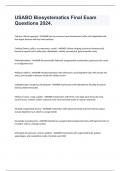
-
USABO Biosystematics Final Exam Questions With Correct Answers 2024.
- Exam (elaborations) • 3 pages • 2024
-
Available in package deal
-
- $10.49
- + learn more
USABO Biosystematics Final Exam Questions With Correct Answers 2024. Calcarea, Silicea (sponges) - ANSWER Lack true tissues; have choanocytes (collar cells-flagellated cells that ingest bacteria and tiny food particles) Cnidaria (hydras, jellies, sea anemones, corals) - ANSWER Unique stinging structures (nematocysts) housed in special cells (cnidocytes); diploblastic, radially symmetrical, gastrovascular cavity Plathyhelminthes - ANSWER Dorsoventrally flattened, unsegmented acoelomates; ...
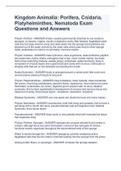
-
Kingdom Animalia: Porifera, Cnidaria, Platyhelminthes, Nematoda Exam Questions and Answers
- Exam (elaborations) • 3 pages • 2022
-
- $9.99
- + learn more
Phylum Porifera - ANSWER simple, sessile (permanently attached to one location) sponges; no tissues, organs, mouth or digestive cavity; filter feeders: flagellated collar cells line the large internal cavity and draw water into the sponge (food particles are strained out of the water current by the collar cells which pass food to other sponge cells); acolemate (no colon); no symmetry; most are marine Phylum Cnidaria - ANSWER class hydrozoa, class scyphozoa, class anthozoa; jellyfish, sea anem...
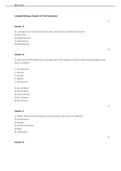
-
Campbell Biology: Chapter 33 Test Preparation
- Exam (elaborations) • 37 pages • 2022
-
- $12.99
- + learn more
A sponge's structural materials (spicules, spongin) are manufactured by theHow many of the following can be observed in the mesohyl of various undisturbed sponges at one time or another?Which chemical is synthesized by some sponges and acts as an antibiotic? A) streptomycin B) spongin C) calcium carbonate D) silica E) cribrostatinIn terms of food capture, which sponge cell is most similar to the cnidocyte of a cnidarian? A) amoebocyte B) choanocyte C) epidermal cell D) pore cellSponges are most...
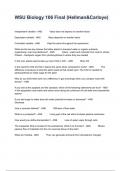
-
WSU Biology 106 Final (Hellman&Carloye) Questions With Correct Solutions
- Exam (elaborations) • 24 pages • 2024
-
- $12.89
- + learn more
WSU Biology 106 Final (Hellman&Carloye) Independent variable - ANS Value does not depend on another factor Dependent variable - ANS Value depends on another factor Controlled variable - ANS Kept the same throughout the experiment What are the two key tissues that allow plants to transport water or organic nutrients, respectively, over long distances? - ANS Xylem - water and minerals from roots to shoots Phloem - transports sugars from ...
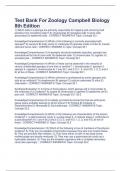
-
Test Bank For Zoology Campbell Biology 8th Edition
- Exam (elaborations) • 12 pages • 2023
-
- $16.49
- + learn more
Test Bank For Zoology Campbell Biology 8th Edition 1) Which cells in a sponge are primarily responsible for trapping and removing food particles from circulating water? A) choanocytes B) mesoglea cells C) pore cells (porocytes) D) epidermal cells - CORRECT ANSWER-A Topic: Concept 33.1 Knowledge/Comprehension 2) Which of the following is correctly associated with sponges? A) osculum B) body cavity C) cnidocytes D) spicules made of chitin E) muscle cells and nerve cells - CORRECT ANSWE...
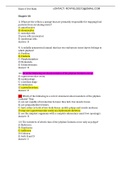
-
Exam 4 Test Bank
- Exam (elaborations) • 24 pages • 2022
-
- $10.49
- + learn more
1) What are the cells in a sponge that are primarily responsible for trapping food particles from circulating water? A) amoebocytes B) choanocytes C) mesohyl cells D) pore cells (porocytes) E) epidermal cells Answer: B 9) A radially symmetrical animal that has two embryonic tissue layers belongs to which phylum? A) Porifera B) Cnidaria C) Platyhelminthes D) Nematoda E) Echinodermata Answer: B 10) All of the following are characteristics of the phylum Cnidaria except A) a gastrovascular cavity. B...
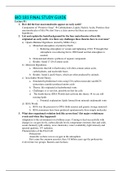
-
BIO 181 FINAL STUDY GUIDE, Latest complete guide (fall 2019/2020)
- Other • 82 pages • 2021
-
- $12.49
- + learn more
BIO 181 FINAL STUDY GUIDE Lecture #1: 1. How did the four macromolecules appear on early earth? Components of “Primitive Soup” Carbohydrates, Lipids, Nucleic Acids, Proteins (four macromolecules of life) We don’t have a clear answer but there are numerous hypotheses. 2. List and explain the basis/ background for the four main theories of how life originated on early earth. Are there any challenges these theories have to overcome? a) Oparin-Haldane Hypothesis (tested by Miller-Urey) a. ...
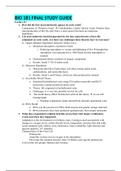
-
BIO 181 FINAL STUDY GUIDE, Latest complete guide (fall 2019/2020)
- Study guide • 83 pages • 2020
-
- $15.49
- + learn more
BIO 181 FINAL STUDY GUIDE Lecture #1: 1. How did the four macromolecules appear on early earth? Components of “Primitive Soup” Carbohydrates, Lipids, Nucleic Acids, Proteins (four macromolecules of life) We don’t have a clear answer but there are numerous hypotheses. 2. List and explain the basis/background for the four main theories of how life originated on early earth. Are there any challenges these theories have to overcome? a) Oparin-Haldane Hypothesis (tested by Miller-Urey) a....
![Cnidaria [PHYLUM] – CH 7](/docpics/5f10e73442df3_767061.jpg)
-
Cnidaria [PHYLUM] – CH 7
- Class notes • 4 pages • 2020
- Available in package deal
-
- $8.99
- + learn more
This chapter summarizes Cnidarians. Emphasis was placed in their classification.
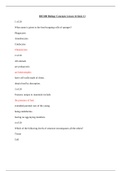
-
BIO100 Biology Concepts Lesson 14 Quiz 11
- Exam (elaborations) • 7 pages • 2018
-
- $14.49
- + learn more
1 of 20 What name is given to the food-trapping cells of sponges? Phagocytes Amoebocytes Cnidocytes Choanocytes 2 of 20 All animals are prokaryotic. are heterotrophic. have cell walls made of chitin. obtain food by absorption. 3 of 20 Features unique to mammals include the presence of hair. extended parental care of the young. being endotherms. having no egg-laying members. 4 of 20 Which of the following levels of structure encompasses all the others? Tissue Cell Organ Organism 5 of 20 Which of ...

How much did you already spend on Stuvia? Imagine there are plenty more of you out there paying for study notes, but this time YOU are the seller. Ka-ching! Discover all about earning on Stuvia


